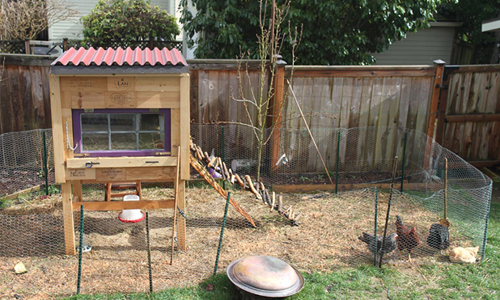

Raising backyard chickens is very trendy these days. With news of arsenic in our chicken and the U.S. Department of Agriculture’s move to allow the sale in the U.S. of chickens processed in China, many people are choosing to raise their own chickens. Businesses around the country are catering to this growing demand among urbanites and suburbanites who want to have their own fresh daily eggs or raise their own chickens for meat by offering chicks, feed, coop design plans and even prebuilt coops.
But raising chickens definitely has its challenges that first-timers might not be aware of before they begin. Jason Price at The Hungry Dog Blog offers the following tips that he has learned through trial and error while raising his own backyard chickens in Seattle, Washington.
1. Go into it with a design plan or buy a pre-built coop: This may seem obvious, but Price wanted to use as much recycled material as possible and do it on the cheap, which you certainly can do. But you should have designs to go off of if you want your coop to be structurally sound. If you want to raise chickens but don’t think you can build your own chicken coop, Modern Farmer has found some very cool, modernist, pre-built chicken coops.
2. Seek out neighbors and chicken farmers in the area: Yes, the internet is full of useful sites for raising backyard chickens, but nothing beats the advice and knowledge of someone with whom you can talk in your area. Seeing other people’s setups will help you troubleshoot your own, and you can have people actually come see your operation and your chickens when you are having problems.
3. Be prepared to stumble upon some horrible chicken deaths: Harsh, but true. Price had a horror story of dog sitting for a demon dog that took out three of his baby chicks. Dogs, weasels, coyotes, raccoons and foxes are just some of the common predators of chickens. This is another reason that it’s best to follow a design plan for a chicken coop so that your hens are well protected.
4. It’s possible you will have a rooster in the brood: Determining the sex of chickens when they are young enough to sell is only about 90 percent accurate, so occasionally you will get a rooster or two in with your hens. It’s illegal (and annoying) to have a rooster in most urban and suburban areas, so you’ll either have to eat the little guy or find him a new home.
5. Don’t expect your chickens to lay eggs on a consistent schedule: The breed helps determines when your chickens should lay eggs, but chickens will often take longer than standard estimates and egg laying will vary with the seasons. Making sure they have good, whole grain food with at least 17 percent protein, a healthy amount of water and ample light will help, but Price warns your hens might lay every day for a month, take a break for a few days, and then lay every other day.
6. Plan to spend lot of time on “chicken blogs”: Much like how parents pore over blogs and books about what’s ailing their sick children, when backyard chicken farmers’ hens get sick, they spend lots of time perusing sites like The Chicken Chick, Backyard Poultry Magazine, Backyard Chickens.com, Oh Lardy’s Backyard Chicken Series and Pam’s Backyard Chickens. Sadly it’s inevitable that you may lose some chickens to disease.
7. Farm life is not all roses: Materials such as straw and Diatomaceous Earth help keep the odor down, but chickens still produce lots of waste, which attracts flies. Price says the best thing to do is to clean and replace your straw weekly and use fly traps.
8. You can’t beat the taste: Before you begin to think this is a list of 10 reasons why not to raise backyard chickens, let’s not forget that fresh, organic eggs and the meat from chickens that you raise yourself taste amazing. Taking ownership of your food by growing and raising it yourself is an empowering feeling.
9. The zen of watching chickens: Price said this surprised him, but he really enjoys watching the chickens express their innate behavior. They all have different personalities, and he gets a kick out of watching them play together.
10. Chickens come and go: Chickens have about two good years of laying before their production declines, and the feed costs more than you save in eggs. You can either eat them or keep them as pets and let them die of old age. And then you can buy more chicks to start the cycle anew. As mentioned previously, you should be prepared to lose a few chickens along the way. Price started with 11 and ended up with 6 due to predators (the evil dog he watched), disease and one being a rooster.
YOU MIGHT ALSO LIKE
The Solution Under Our Feet: How Regenerative Organic Agriculture Can Save the Planet

 233k
233k  41k
41k  Subscribe
Subscribe 
